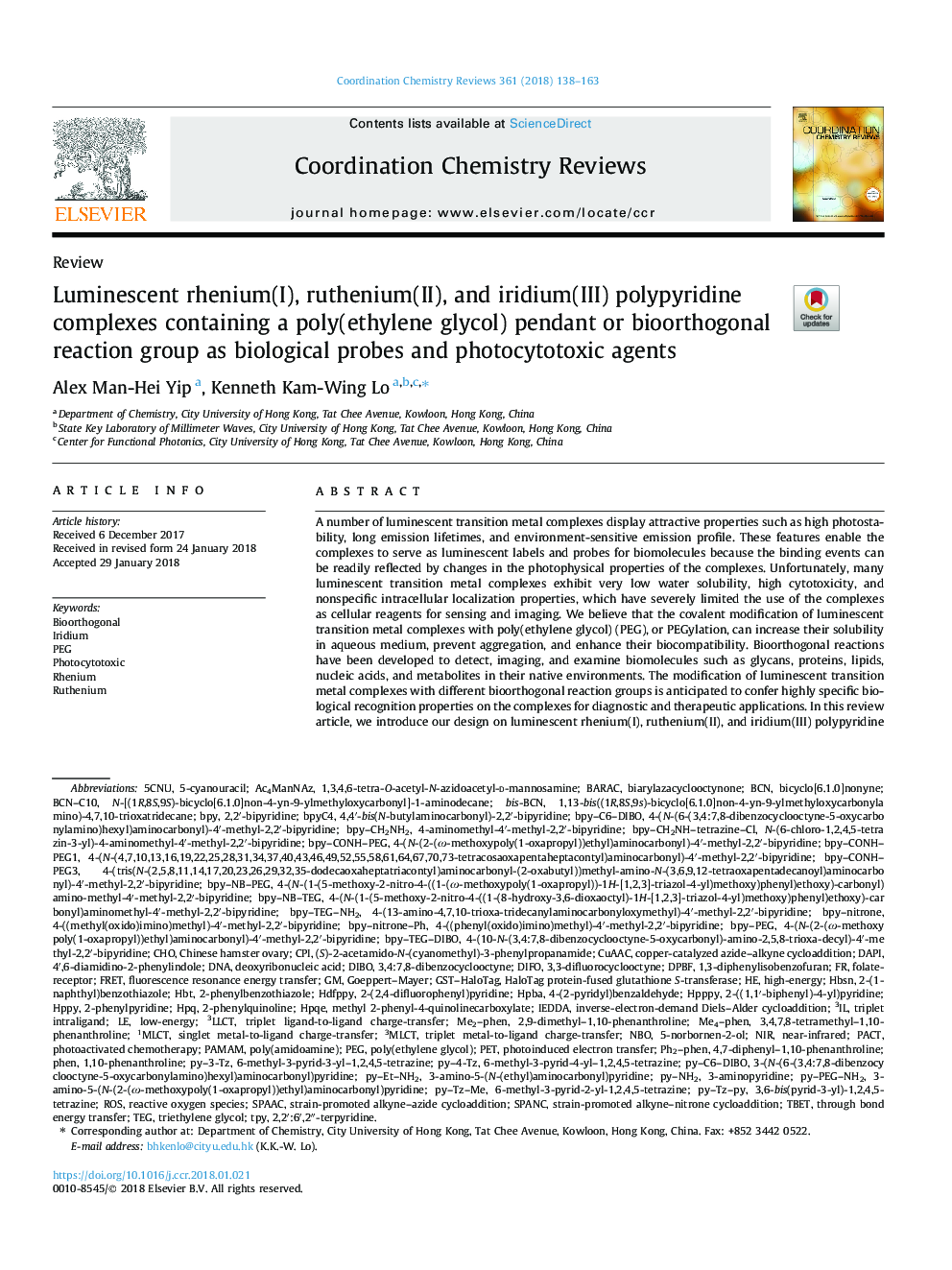| کد مقاله | کد نشریه | سال انتشار | مقاله انگلیسی | نسخه تمام متن |
|---|---|---|---|---|
| 7747637 | 1498667 | 2018 | 26 صفحه PDF | دانلود رایگان |
عنوان انگلیسی مقاله ISI
Luminescent rhenium(I), ruthenium(II), and iridium(III) polypyridine complexes containing a poly(ethylene glycol) pendant or bioorthogonal reaction group as biological probes and photocytotoxic agents
دانلود مقاله + سفارش ترجمه
دانلود مقاله ISI انگلیسی
رایگان برای ایرانیان
کلمات کلیدی
TEGHPBA2-(2,4-difluorophenyl)pyridineHppyTPY2-Phenylbenzothiazole3MLCTHPQSPAACbpyTBETBCNPACTCuAACDPBFDAPINIRCPINBO1,10-Phenanthroline - 1،10-Phenanthroline1,3-diphenylisobenzofuran - 1،3-دیفنیلیزوبنزوفوران2-Phenylpyridine - 2-فنیل پیریدین2-phenylquinoline - 2-فنیل کینولین2,2′:6′,2″-Terpyridine - 2،2 ': 6'، 2 "-Terpyridine2,2′-Bipyridine - 2،2'-بپییریدین3-Aminopyridine - 3-آمینوپیریدین4′,6-diamidino-2-phenylindole - 4 '، 6-دیامیدینو-2-فنیلینولDNA - DNA یا اسید دزوکسی ریبونوکلئیکROS - ROSdeoxyribonucleic acid - اسید deoxyribonucleicPhotoinduced electron transfer - انتقال الکترون های دیجیتالFluorescence resonance energy transfer - انتقال انرژی رزونانس FluorescenceFRET - انتقال انرژی رزونانسی فورسترhigh-energy - انرژی بالاIridium - ایریدیمCho - برایBioorthogonal - بیوروژگانالChinese Hamster Ovary - تخمدان هامستر چینیTriethylene glycol - تری اتیلن گلیکولHBT - دگرباشان جنسیRhenium - رنیومRuthenium - روتنیوم Phen - فینNear-infrared - نزدیک مادون قرمزPAMAM - پامامPET - پتpoly(amidoamine) - پلی آمیدامینPoly(ethylene glycol) - پلی اتیلن گلایکول PEG - پلیاتیلن گلیکول Low-energy - کم انرژیReactive oxygen species - گونههای فعال اکسیژن
موضوعات مرتبط
مهندسی و علوم پایه
شیمی
شیمی معدنی
پیش نمایش صفحه اول مقاله

چکیده انگلیسی
A number of luminescent transition metal complexes display attractive properties such as high photostability, long emission lifetimes, and environment-sensitive emission profile. These features enable the complexes to serve as luminescent labels and probes for biomolecules because the binding events can be readily reflected by changes in the photophysical properties of the complexes. Unfortunately, many luminescent transition metal complexes exhibit very low water solubility, high cytotoxicity, and nonspecific intracellular localization properties, which have severely limited the use of the complexes as cellular reagents for sensing and imaging. We believe that the covalent modification of luminescent transition metal complexes with poly(ethylene glycol) (PEG), or PEGylation, can increase their solubility in aqueous medium, prevent aggregation, and enhance their biocompatibility. Bioorthogonal reactions have been developed to detect, imaging, and examine biomolecules such as glycans, proteins, lipids, nucleic acids, and metabolites in their native environments. The modification of luminescent transition metal complexes with different bioorthogonal reaction groups is anticipated to confer highly specific biological recognition properties on the complexes for diagnostic and therapeutic applications. In this review article, we introduce our design on luminescent rhenium(I), ruthenium(II), and iridium(III) polypyridine complexes functionalized with a PEG or bioorthogonal reaction group as cellular reagents. The photophysical, photochemical, cellular uptake, and (photo)cytotoxic activity of these complexes are described and discussed.
ناشر
Database: Elsevier - ScienceDirect (ساینس دایرکت)
Journal: Coordination Chemistry Reviews - Volume 361, 15 April 2018, Pages 138-163
Journal: Coordination Chemistry Reviews - Volume 361, 15 April 2018, Pages 138-163
نویسندگان
Alex Man-Hei Yip, Kenneth Kam-Wing Lo,